Telehealth in InSync EMR with Curogram
💡 Telehealth in InSync EMR brings secure, app-free virtual care to behavioral health practices. Providers can see patients anywhere while keeping...
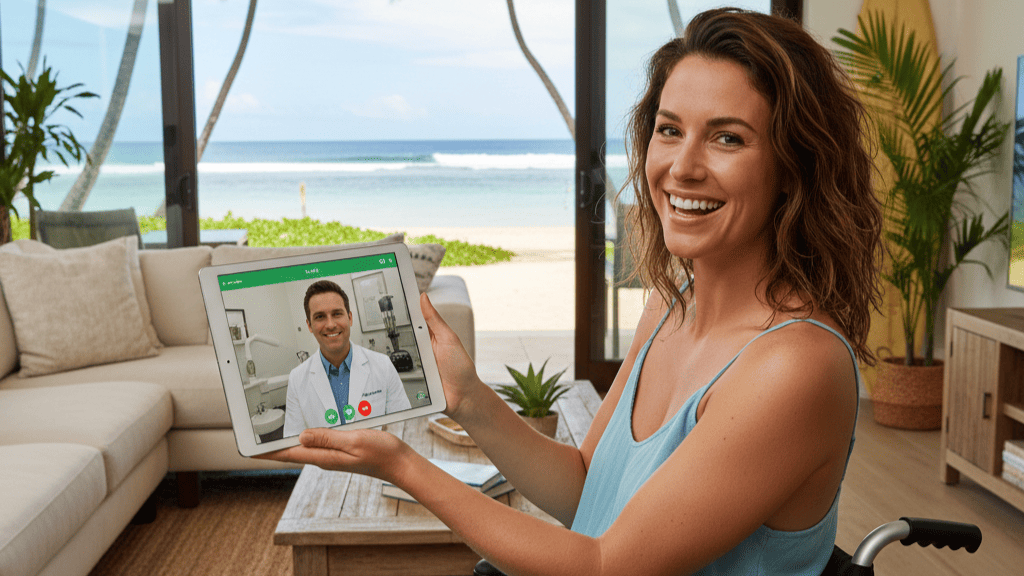
Host HIPAA-compliant video visits with no downloads.
Connect directly to DrChrono scheduling and patient charts.
Reduce no-shows by offering flexible care options.
Serve rural and mobility-limited patients efficiently.
Boost satisfaction with quick, device-friendly virtual care.
Curogram integrates seamlessly with DrChrono to make virtual visits effortless. With one login and zero tech hurdles, clinics can expand access and give care beyond clinic walls.
When patients can't go to their appointments, care shouldn’t stop. That’s the promise of telehealth in DrChrono. It's a way to connect face-to-face, safely and simply, no matter where patients are. For small clinics, offering virtual care is now a lifeline that keeps care consistent.
This blog explores why telehealth matters for small and mid-sized clinics. You'll learn how Curogram powers HIPAA-compliant DrChrono virtual care. Discover the tangible benefits practices experience once they make the switch.
Near the end, we'll discuss a quick setup guide to get started. Curogram integrates directly into DrChrono, removing the complexity of managing separate systems.
Ready to learn how streamlined, secure, and accessible telehealth works? Keep reading.
Healthcare has changed. Patients expect convenience, and many prefer connecting from home rather than driving across town. For small practices, telehealth isn’t just about technology—it’s about staying relevant and meeting patients where they are. It’s about removing access barriers that keep people from getting the care they need.
When a patient misses an appointment, it’s more than a scheduling inconvenience—it’s lost revenue, lost time, and delayed care. No-shows are often caused by transportation issues, weather, or work conflicts. Offering a virtual alternative can prevent many of these missed visits and keep schedules full. It helps practices maintain continuity while showing patients that flexibility is part of the service.
Staff, too, benefit from simplicity. Running multiple apps for scheduling, video calls, and documentation creates confusion and errors. By embedding telehealth in DrChrono, all workflows happen in one place—appointments, notes, billing, and patient communication. This keeps operations clean and efficient for small teams.
Curogram’s integration with DrChrono brings telehealth directly into the EMR environment. Providers can schedule, launch, and document online visits without leaving their existing workflow. Each session is secure, HIPAA-compliant, and requires no software installation or special app. Patients join from a text or email link—no accounts, no passwords, no confusion.
Sessions run smoothly on any device—desktop, tablet, or smartphone—making them accessible for patients of all ages. The interface is intuitive enough that even first-time users can connect with one click. Behind the scenes, the system manages encryption and compliance automatically, allowing providers to focus on care instead of tech troubleshooting.
Curogram also integrates scheduling, reminders, and documentation directly with DrChrono. Appointments appear automatically in the EMR, and visit notes attach to the patient’s chart in real time. After each session, billing data syncs seamlessly, saving staff hours of reconciliation. This one-system approach eliminates duplication and error-prone manual updates.
For clinics, this means telehealth becomes an effortless extension of in-person care. It’s the same DrChrono schedule, the same patient flow—just with more flexibility and reach. Patients feel supported, and providers regain control of their time. It’s the perfect balance between convenience and continuity.
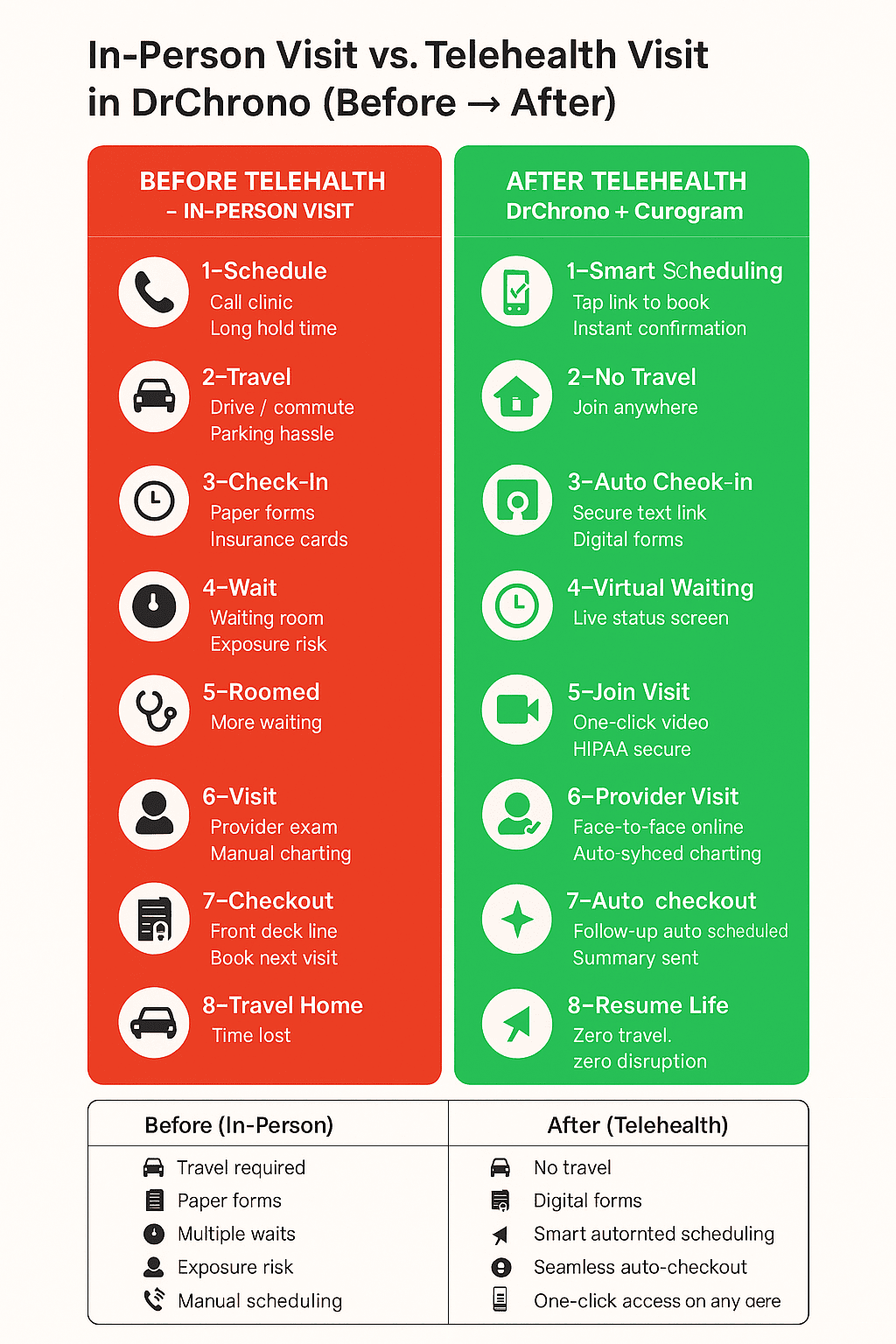
Telehealth in DrChrono helps small clinics reach patients who normally struggle to attend in-person visits. People living in rural areas, seniors with mobility challenges, and busy parents can now connect from wherever they feel safe and comfortable. When care becomes easier to reach, patients stop delaying important check-ins. Over time, this builds stronger relationships and trust.
Missed appointments cost clinics time, money, and emotional energy. Virtual visits remove common barriers like bad weather, car trouble, or last-minute schedule conflicts. Patients simply click a link and join from wherever they are. This simple shift helps stabilize daily schedules and reduces stress for staff.
Patients appreciate having choices. When they feel supported through a flexible system that meets them halfway, their satisfaction naturally rises. Telehealth lets them skip the waiting room, avoid long drives, and still feel heard and cared for. Happy patients are more likely to return and recommend the practice to others.
With telehealth built directly into DrChrono, staff no longer switch between apps or chase logins. Scheduling, reminders, notes, and documentation all stay in one place. This saves mental energy and reduces errors. The clinic feels calmer and more organized.
Virtual visits help clinics protect revenue by keeping schedules full. Follow-ups, chronic care checks, and urgent consults continue even when patients can’t come in person. This reduces cancellations and keeps cash flow steady. For small clinics, that consistency makes a huge difference.
Patients can stay connected between visits, especially when they have chronic conditions or need frequent monitoring. Providers can check symptoms, adjust medications, and review progress through short virtual meetings. This prevents complications and improves long-term outcomes. Patients feel supported every step of the way.
Fewer in-person appointments mean less strain on waiting room space, cleaning supplies, and front-desk staff. Clinics can operate efficiently without expanding their physical footprint. This helps small practices keep costs down while still offering high-quality care. The savings add up month after month.
Telehealth makes it easier for patients to accept follow-up appointments because they don’t have to rearrange their whole day. Instead of waiting weeks, they can connect within days. Providers can address concerns quickly before they grow into bigger problems. This keeps care proactive instead of reactive.
Clinics can expand services without adding physical rooms or additional staff. Telehealth allows for mental health visits, nutrition counseling, medication management, and more. It also creates opportunities for collaborative care between specialists and primary care providers. Patients benefit from a wider range of support.
Doctors can balance their day with a mix of in-office and virtual visits. This reduces physical fatigue and gives them more control over their schedules. A balanced workflow helps prevent burnout and supports long-term job satisfaction. When providers feel better, patients feel it too.
During flu season or other outbreaks, telehealth protects both staff and patients. People with symptoms can still receive care without exposing others in the clinic. This helps reduce the spread of illness and keeps operations running smoothly. Small clinics stay safer and more stable.
Surprisingly, virtual visits often feel more personal because patients are in their own environment. Providers can see what life looks like at home—medications on the counter, mobility aids, or family support. These small details help clinicians understand the patient’s reality better. Conversations become warmer and more human.
Family members caring for elderly or disabled relatives often struggle with transporting them to appointments. Telehealth reduces this burden dramatically. Caregivers feel relief knowing they can help their loved ones receive care without the physical strain. This support builds emotional goodwill and deeper loyalty to the clinic.
Front-desk teams spend less time checking in patients, managing waiting rooms, or coordinating transportation questions. Instead, they can focus on meaningful tasks like patient outreach or care coordination. Their day feels more manageable and productive. Morale improves as stress decreases.
Larger health systems already offer virtual visits, and patients expect the same convenience everywhere. Offering telehealth in DrChrono levels the playing field for small clinics. It shows that they are modern, responsive, and committed to patient-centered care. This helps attract new patients and retain existing ones.
A family clinic in Colorado struggled with chronic care follow-ups because many patients lived far away or didn’t have reliable transportation. Once the clinic added telehealth in DrChrono through Curogram, those follow-up visits increased by 20% in just a few weeks. Patients shared how relieved they felt not having to arrange rides or take hours off work. The clinic noticed fewer gaps in treatment plans and stronger relationships with long-term patients.
In Texas, an urgent care center faced unpredictable no-shows during peak flu season. After switching to virtual visits, nearly a quarter of those lost appointments turned into billable telehealth consults. Providers could handle large patient volumes safely, and patients appreciated the quick access without risking exposure. What started as a temporary solution quickly became a cornerstone of their patient care model.
A pediatric practice in Arizona also saw transformative results. Parents with newborns, toddlers, or multiple kids often dreaded in-office appointments due to the chaos of travel. With telehealth integrated into DrChrono, they could complete check-ins and discuss concerns from home. The waiting room stayed calmer, and parents expressed genuine gratitude for the flexibility. Satisfaction scores rose quickly, proving that convenience matters deeply to families.
Launching telehealth in DrChrono is easier than most clinics expect, especially with Curogram guiding the process. The setup is quick, the workflow is intuitive, and staff usually feel confident after one short training session. Most importantly, clinics don’t need expensive equipment or complicated technology. A simple, patient-friendly approach makes virtual care feel natural from day one.
Below is a clear and simple checklist to get your clinic started:
By following these steps, clinics can build a telehealth program that feels natural, supportive, and beneficial to every patient they serve. Curogram provides guidance through every phase, so the process never feels overwhelming.
Curogram makes telehealth feel simple, even for clinics with small teams and limited time. Everything is built around ease—easy for staff to use, easy for patients to join, and easy for providers to manage without juggling extra apps. It connects directly to DrChrono, so virtual visits look and feel like a natural part of your existing workflow. There are no extra logins, no confusing tech steps, and no heavy IT setup to worry about.
Because Curogram was designed for healthcare, every feature supports the emotional and practical needs of small clinics. Sessions are HIPAA-compliant, reminders are automatic, and patient links open instantly on any device. Even grandparents who struggle with technology usually join without trouble. When patients feel confident, they show up—virtually and emotionally.
For providers, Curogram gives back something priceless: time. They can balance in-person and virtual appointments, complete documentation faster, and stay fully connected to their patients. For clinic administrators, it brings stability—reduced no-shows, smoother workflows, predictable revenue, and happier staff. Curogram transforms telehealth in DrChrono into more than just video calls. It becomes a lifeline for connection, flexibility, and compassionate care.
Telehealth in DrChrono is an ideal way for clinics to stay connected with their patients. When people can meet with their provider where they are, they feel supported. That emotional connection matters just as much as the medical care itself. It shows patients that your clinic is flexible, thoughtful, and ready to meet them where they are.
Curogram makes this vision real by removing all the technical hurdles. With one-click video visits, integrated scheduling, and secure documentation, telehealth becomes simple. Providers save time, patients stay engaged, and schedules stay full. It’s a simple change that creates meaningful impact in daily operations.
Want to see what HIPAA-compliant telehealth looks like? Book a quick demo today.
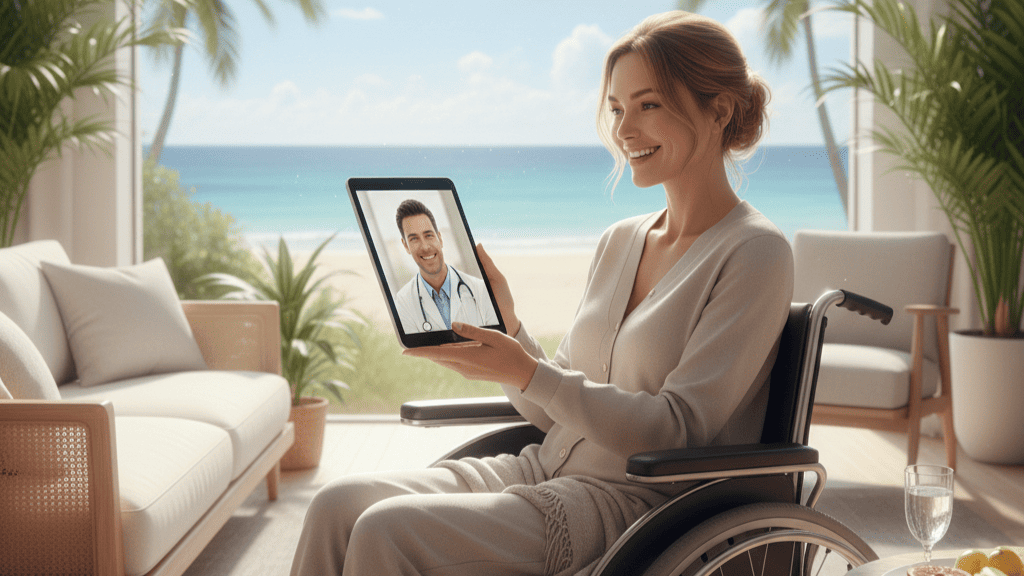
💡 Telehealth in InSync EMR brings secure, app-free virtual care to behavioral health practices. Providers can see patients anywhere while keeping...
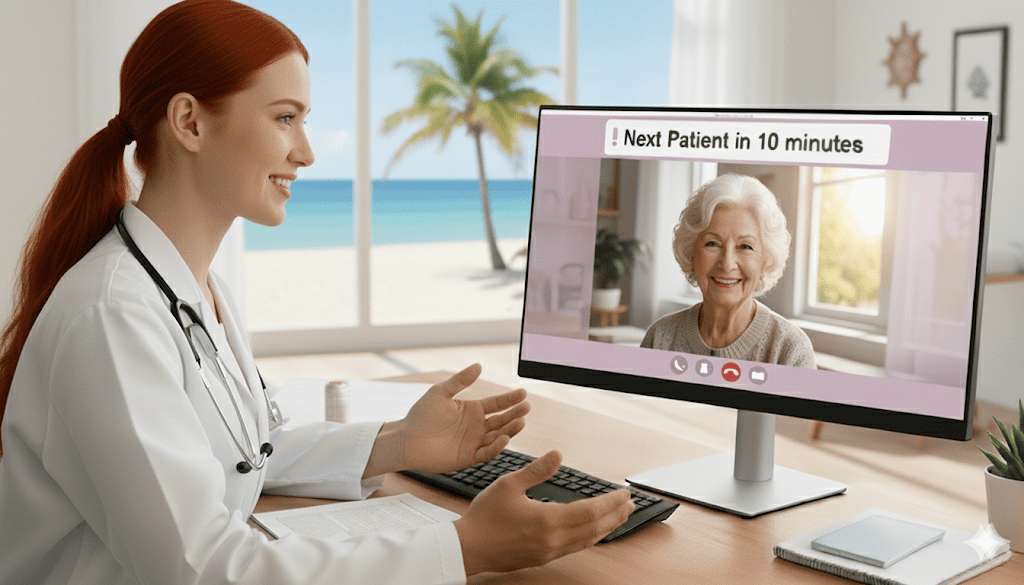
💡 Choosing the best HIPAA-compliant telehealth platform for Tebra users is crucial. At minimum, it must improve patient access, reduce no-shows,...
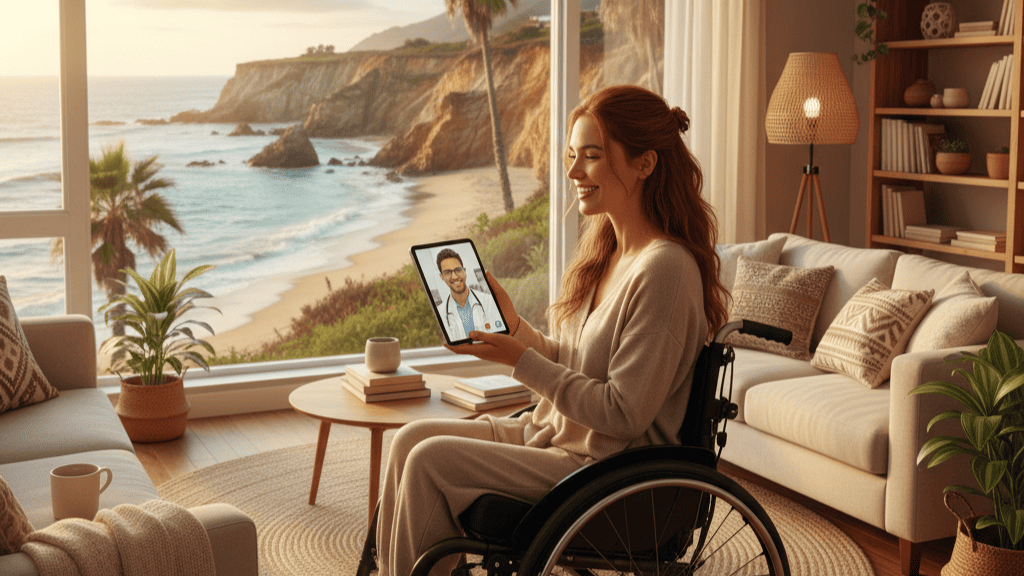
💡 Telehealth in Konica Minolta Exa connects radiology providers and patients virtually. HIPAA-compliant telemedicine is the key to improve...